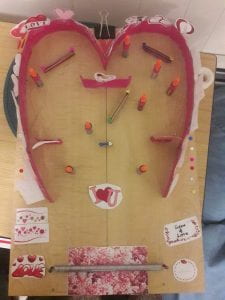The Game of Love



Rules:
In The Game of Love, you use the spring at the bottom to attempt to launch a small puck into the three scoring spaces. The player is able to manipulate the spring in anyway that they deem necessary, as long as it is attached to at least one of the anchoring nails. The top space is harder to score in, and therefore worth more points.
Appropriations
However, there is no way to track points or to win in a conventional sense. This is partly because of what the game is appropriating. The style of the artifact is based on the old plastic handheld toys like Rings and Pocket Pachinko. These games had self imposed win states and play times, as there were no clear counters to determine points or score. It also takes elements of pinball. The idea is to make something very tactile and playful, where even playing with it feels good. This is to be juxtaposed against the content and building materials of the artifact. The main board are two detached shelves, and the obstacles are made from old cardboard, dead batteries, electrical bits and bobs, and cheap craft supplies, finally covered in bright pink duct tape and paper cutouts of generic symbols and images of love and romance. It is designed to look kitsch and horrible as a whole and on the exterior, while also having a clearly fumbled together look.
Meaning
The juxtaposition between the kitsch love and romance aesthetic, the disheveled appearance and construction, and the very gamey tactility all come together to represent the worst parts of love in our culture. Society’s idea of love is commercial, it is skin deep, and it is seen in a lot of ways as a game. People and relationships are objectified into raw materials, where game-like tactics and materialism become the background to how achieving love is conveyed. To gamify love in any fashion is to be disingenuous and cynical towards the complexity of relationships and people as a whole. And in this game, there is ultimately no winning. There is no reward, there are no systems tracking progress or skill. The game acts merely as an instrument for the players amusement, which captures the most cynical and deplorable outlooks on love and human intimacy.
Inspiration:
This piece is heavily inspired by the appropriation pieces in Gallery 360. A lot of them focused on a kind of playfulness that I think is enhanced by the idea of appropriation. There was one piece that was even a game in its own right. I also really liked the Dada appropriation idea of taking a useful object and rendering it useless. In my case, I had many of the artifacts that made up the structural elements of my piece be items that are involved in repair or electronics, such as a spare spring for machinery, batteries, and wire connectors. This also lends metaphorical meaning into the piece. The thing that inspired this piece the most is the Dada idea of anti-art, where one would make something so unpretentious and unappealing that it would subvert expectations in a strange and interesting way.
Original Prototype:

This version was built with constraints of having to be attached to a table, meaning that the only way to play the game was horizontal. This takes out the gravity mechanic that not only makes the game more satisfying to play, but also properly alludes to the material the artifact is appropriating. Play-tests indicated that the difficulty was not properly balanced, and the nature of limitations made it almost impossible to score, which erases how misleadingly satisfying the final artifact is meant to be to play with it.
